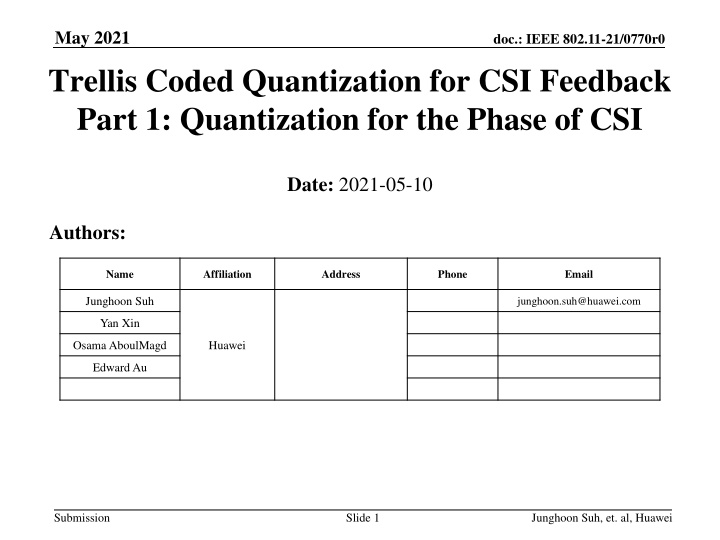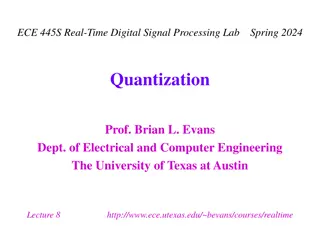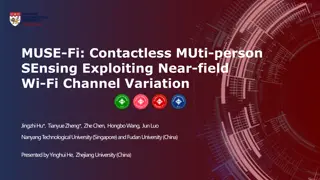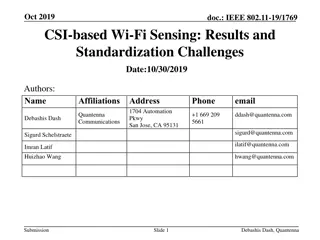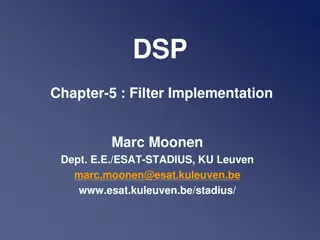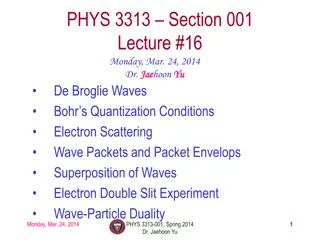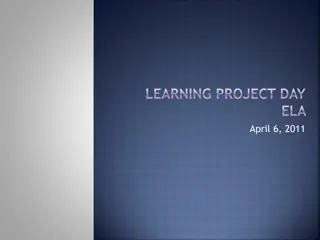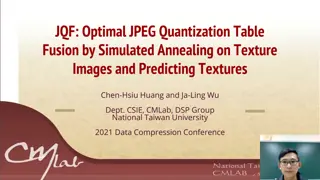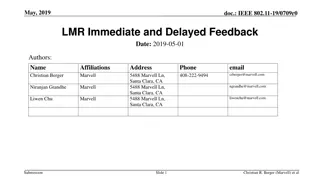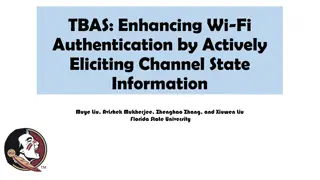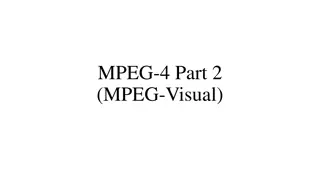May 2021: Trellis Coded Quantization for CSI Feedback - Part 1
CSI feedback in wireless communication systems plays a crucial role in optimizing information transmission. This document discusses trellis coded quantization techniques for improving the feedback process, focusing on quantization for the phase of Channel State Information (CSI). The article delves into the mathematical representation of CSI, transformations into magnitude and phase, and feedback strategies to minimize loss of information. The use of scalar quantization, singular matrix decomposition, and convolutional encoding/decoding for sensing signal analysis are highlighted.
Download Presentation

Please find below an Image/Link to download the presentation.
The content on the website is provided AS IS for your information and personal use only. It may not be sold, licensed, or shared on other websites without obtaining consent from the author.If you encounter any issues during the download, it is possible that the publisher has removed the file from their server.
You are allowed to download the files provided on this website for personal or commercial use, subject to the condition that they are used lawfully. All files are the property of their respective owners.
The content on the website is provided AS IS for your information and personal use only. It may not be sold, licensed, or shared on other websites without obtaining consent from the author.
E N D
Presentation Transcript
May 2021 Trellis Coded Quantization for CSI Feedback Part 1: Quantization for the Phase of CSI doc.: IEEE 802.11-21/0770r0 Date: 2021-05-10 Authors: Name Affiliation Address Phone Email Junghoon Suh junghoon.suh@huawei.com Yan Xin Osama AboulMagd Huawei Edward Au Submission Slide 1 Junghoon Suh, et. al, Huawei
May 2021 doc.: IEEE 802.11-21/0770r0 Background CSI is one of the sensing measurement type for sub 7 GHz band [1] The CSI represents the combined effect of scattering, fading, power attenuation of the wireless medium and the motions of objects It is mathematically represented in a complex number, and thus, can be transformed into the magnitude and phase The phase samples are always uniformly distributed The magnitude is approximately Rayleigh-distributed It may be an implementation specific how to extract the information caused by the motions of objects inherent to the measured CSI information 802.11 focuses on how to feedback the measured CSI information with the minimized loss of information Submission Slide 2 Junghoon Suh, et. al, Huawei
May 2021 doc.: IEEE 802.11-21/0770r0 802.11ac/ax/be CSI Feedback The measured CSI is SVD-decomposed and can be represented in a multiplication of the Left-singular matrix, Eigen-value matrix and the Right-singular matrix The Eigen-values are fed back in the average SNR per OFDM symbol and Stream, and delta SNR per sub-carrier (actually every other sub-carrier) The Right-singular matrix are fed back in the series of angle-quantized Givens rotation matrix A scalar quantization is used for the angle-quantization (angle samples are uniformly distributed) The Left-singular matrix are not fed back, because it is a unitary matrix with the phase information only which does not impact on the Beamforming Steering matrix However, for a sensing signal analysis, a full CSI is needed without loss of information Submission Slide 3 Junghoon Suh, et. al, Huawei
May 2021 doc.: IEEE 802.11-21/0770r0 TCQ Sensing Receiver runs a convolutional decoder such as a Viterbi decoder to compute the beginning state, input bits, and a sub-codebook index Sensing Transmitter runs a convolutional encoder using the fed-back beginning state, input bits and the sub-codebook index to recover the matching branch-label which is the quantized phase per subcarrier Convolutional Encoder ; Begins from the beginning state Received signal Sensing Frame Channel Estimation Trellis Stage corresponds to each subcarrier (or group of subcarriers depending on Ng size) Obtain the Phase Information Run VA Figure out the matching branch label which is the Quantized phase per Subcarrier CSI Measurement FB Beginning State, input bits, Sub-codebook index Feedback Sensing Receiver Sensing Transmitter Submission Slide 4 Junghoon Suh, et. al, Huawei
May 2021 Operation of VA and its corresponding Convolutional Encoder: Use the current 802.11 BCC trellis scheme doc.: IEEE 802.11-21/0770r0 = + u * 2 ( = * S )% + 64 32 S S S u Forward State Transition Function: 1 i i ) 2 / i ( Backward State Transition Function: 1 i i b Output of VA, that is, the input to Convolutional Encoder: - The output bits over all trellis stages, and the beginning state of the survival path determines the unique sub-codebook index - For the rate 1/2 code, the output bit of VA per trellis stage is 1 bit. - The size of each sub-codebook is 2n-1 where n is the feedback bit size per trellis stage Submission Slide 5 Junghoon Suh, et. al, Huawei
May 2021 doc.: IEEE 802.11-21/0770r0 TCQ: for the uniform-distributed source such as the phase information of CSI [2] For an n-bit TCQ quantizer, the codebook is divided into four sub-codebooks, each with N/2 codewords, where N = 2n. When the i-th (0<= i <= 3) sub-codebook is denoted as ??= ? ? ?, where ??,? is the l-th codeword in Ci . These sub-codebooks are generated in the following way. Let Lb and Ub be the lower and upper bounds of source data. Let =?? ?? ??,??=? ?/2 and ? = 4=?? ?? 2? , then ??,?=??+ ? + ? + 0.5 ?. Depending on the trellis scheme, Ci can be arranged to make the distance between Ci s maximallyequal, when mapped to the trellis output bits. Submission Slide 6 Junghoon Suh, et. al, Huawei
May 2021 doc.: IEEE 802.11-21/0770r0 Let s take an example with 8 bit TCQ, N=28=256 and the source data samples to be quantized being uniformly distributed between -? ??? ? There are 4 sub-codebooks and 128 codewords in each sub-codebook, thus, C0 to C3 are obtained as follows according to the method in slide 6 ??= { ?.?????????, ?.?????????, ., ??= { ?.?????????, ?.???????, .., ??= { ?.?????????, ?.?????????, ..., ??= { ?.?????????, ?.?????????, .. ., The Lb and Ubin the previous slide corresponds to ? ??? ? , respectively, and ? is 3.14159265359 ?.?????????, 3.098641164} ?.?????????, 3.11091301} ?.?????????, 3.123184856} ?.?????????, 3.135456702} Submission Slide 7 Junghoon Suh, et. al, Huawei
May 2021 doc.: IEEE 802.11-21/0770r0 1/01 The subscript i in Ci corresponds tothe output bits in a state transition, and the 00 is paired with 11 and 01 is paired with 10 in the outgoing branches from a state as we see from the figure beside In order to make the distances among sub-codebooks maximally equal, ?? ??? ??correspond to the output bit 00, ??correspond to 01, ??correspond to 11, and ??correspond to 10 63 63 0/10 62 62 1/00 61 0/11 60 .. .. . 15 14 1/01 13 0/10 12 1/00 11 0/11 10 1/10 9 0/01 8 1/11 7 7 0/00 6 6 1/01 5 5 Therefore, each outgoing branch from a state has a corresponding output and thus has a corresponding sub-codebook 0/10 4 4 1/00 0/11 3 3 1/10 2 2 0/01 1/11 1 1 0/00 0 0 Submission Slide 8 Junghoon Suh, et. al, Huawei
May 2021 doc.: IEEE 802.11-21/0770r0 Example for an illustration: 4 state with coderate and n = 2 bits (N=4) for simplification purpose ??= { ?.?????????,?.?????????} corresponds to output bit 00 ??= { ?.?????????,?.??????????} corresponds to output bit 01 ??= { ?.?????????,?.?????????} corresponds to output bit 11 ??= { ?.?????????,?.?????????} corresponds to output bit 10 The source data between L and U i? ? ? ?? ?? ?? ?? ? ?? ?? ?? ?? ?? ?? ? ? ? ? ?? ?? ? ? ? ?? ?? ? ? ?? ? ? ?? ? ? ?? ?? ?? ?? ?? ?? ?? ?? ? ? ?? ?? ?? ?? ?? ?? ?? ?? ?? ?? ? 1/01 1/01 1/01 1/01 3 3 3 3 3 0/10 0/10 0/10 0/10 1/10 1/10 1/10 1/10 2 2 2 2 2 0/01 0/01 0/01 0/01 1/00 1/00 1/00 1/00 0/11 0/11 1 1 1 1 1 0/11 0/11 1/11 1/11 1/11 1/11 0/00 0/00 0/00 0/00 0 0 0 0 0 Submission Slide 9 Junghoon Suh, et. al, Huawei
May 2021 doc.: IEEE 802.11-21/0770r0 Branch metric = ( ?-??,?)2 Node metric = Previous Node metric + Branch metric = . 2 3562 1= = 0813 . 2 = 1178 . 2959 . 1 0 2 3 1/01 1/01 1/01 1/01 3 3 3 3 3 0/10 0/10 0/10 0/10 0.154216897 0 1/10 1/10 1/10 1/10 2 2 2 2 2 0/01 0/01 0/01 0/01 0.154216897 0 1/00 1/00 1/00 1/00 0/11 0/11 1 1 1 1 1 0/11 0/11 0.154208 0 1/11 1/11 1/11 1/11 0/00 0/00 0/00 0/00 0 0 0 0 0 0.154208 0 Submission Slide 10 Junghoon Suh, et. al, Huawei
May 2021 doc.: IEEE 802.11-21/0770r0 = . 2 3562 1= = 0813 . 2 = 1178 . 2959 . 1 0 2 3 1/01 1/01 1/01 1/01 3 3 3 3 3 0/10 0/10 0/10 0/10 0.154216897 0 0.168094386 1 1/10 1/10 1/10 1/10 2 2 2 2 2 0.168085489 1 0/01 0/01 0/01 0/01 0.154216897 0 1/00 1/00 1/00 1/00 0/11 0/11 1 1 1 1 1 0/11 0/11 0.154208 0 0.599891629 1 1/11 1/11 1/11 1/11 0/00 0/00 0/00 0/00 0 0 0 0 0 0.599900526 1 0.154208 0 Submission Slide 11 Junghoon Suh, et. al, Huawei
May 2021 doc.: IEEE 802.11-21/0770r0 = . 2 3562 1= = 0813 . 2 = 1178 . 2959 . 1 0 2 3 1/01 1/01 1/01 1/01 3 3 3 3 3 0/10 0/10 0/10 0/10 0.154216897 0 0.182208917 0.168094386 1 0 0.61400616 0 1/10 1/10 1/10 1/10 2 2 2 2 2 0.168085489 1 0/01 0/01 0/01 0/01 0.154216897 0 1/00 1/00 1/00 1/00 0/11 0/11 1 1 1 1 1 0/11 0/11 0.154208 0 0.599891629 1 0.612432479 0 1/11 1/11 1/11 1/11 0/00 0/00 0/00 0/00 0 0 0 0 0 0.599900526 1 0.154208 0 0.985668111 0 Submission Slide 12 Junghoon Suh, et. al, Huawei
May 2021 doc.: IEEE 802.11-21/0770r0 = . 2 3562 1= = 0813 . 2 = 1178 . 2959 . 1 0 2 3 1/01 1/01 1/01 1/01 3 3 3 3 3 0/10 0/10 0/10 0/10 0.154216897 0 0.182208917 .688001984 0 0.168094386 1 0 0.61400616 0 1/10 1/10 1/10 1/10 2 2 2 2 2 0.168085489 1 0/01 0/01 .257778422 0/01 0/01 0.154216897 0 0 1/00 1/00 1/00 1/00 0/11 0/11 1 1 1 1 1 0/11 0/11 0.154208 0 0.599891629 1 0.612432479 0 .874615473 1 1/11 1/11 1/11 1/11 0/00 0/00 0/00 0/00 0 0 0 0 0 0.599900526 1 0.154208 0 1.246277424 1 0.985668111 0 Submission Slide 13 Junghoon Suh, et. al, Huawei
May 2021 These are the bits to feedback: doc.: IEEE 802.11-21/0770r0 Codewords Index: {0, 1, 0, 0} Input Bits to Convolutional Encoder: {1, 1, 1, 0} Beginning State: 3 = . 2 3562 1= = 0813 . 2 = 1178 . 2959 . 1 0 2 3 1/01 1/01 1/01 1/01 3 3 3 3 3 0/10 0/10 0/10 0/10 0.154216897 0 0.182208917 .688001984 0 0.168094386 1 0 0.61400616 0 1/10 1/10 1/10 1/10 2 2 2 2 2 0.168085489 1 0/01 0/01 .257778422 0/01 0/01 0.154216897 0 0 1/00 1/00 1/00 1/00 0/11 0/11 1 1 1 1 1 0/11 0/11 0.154208 0 0.599891629 1 0.612432479 0 .874615473 1 1/11 1/11 1/11 1/11 0/00 0/00 0/00 0/00 0 0 0 0 0 0.599900526 1 0.154208 0 1.246277424 1 0.985668111 0 Submission Slide 14 Junghoon Suh, et. al, Huawei
May 2021 These are the bits fed-back to Initiator to recover the source from the codebooks: doc.: IEEE 802.11-21/0770r0 Input Bits to Convolutional Encoder: {1, 1, 1, 0} Codewords Index: {0, 1, 0, 0} Beginning State: 3 ??= { ?.?????????,?.?????????} corresponds to output bit 00 ??= { ?.?????????,?.??????????} corresponds to output bit 01 ??= { ?.?????????,?.?????????} corresponds to output bit 11 ??= { ?.?????????,?.?????????} corresponds to output bit 10 Forward State Transition Function: ??= 2 ?? 1%4 + ?? -0.392699082 -1.963495408 Recovered data: 1.1780972453 -1.963495408 1/01 1/01 1/01 1/01 3 3 3 3 3 0/10 0/10 0/10 0/10 1/10 1/10 1/10 1/10 2 2 2 2 2 0/01 0/01 0/01 0/01 1/00 1/00 1/00 1/00 0/11 0/11 1 1 1 1 1 0/11 0/11 1/11 1/11 1/11 1/11 0/00 0/00 0/00 0/00 0 0 0 0 0 = . 2 = 0813 . 2 1= 3562 = 1178 . 2959 . 1 2 0 3 Submission Slide 15 Junghoon Suh, et. al, Huawei
May 2021 doc.: IEEE 802.11-21/0770r0 Simulation We used the same convolutional scheme as in 802.11 (Slide 5) We generated the Chan D to measure the CSI information Phase information is computed per each subcarrier Uniform Distribution 8 bit TCQ n = 8 and N=28=256 Source to Quantization Noise Ratio (SQNR) : 10log(E(x2)/E(q2)) (dB), where x is the source data and q is the quantization noise TCQ shows 1 dB gain compared to the Scalar Quantization (SQ) It is aligned with [3] This result implies saving 1 bit each subcarrier to get the similar performance to the SQ MSE (E(q2)) TCQ SQ (Scalar Quantization) SQNR (dB) 52.673 51.7089 3.98e-5 4.97e-5 Submission Slide 16 Junghoon Suh, et. al, Huawei
May 2021 doc.: IEEE 802.11-21/0770r0 Summary TCQ shows 1 dB gain compared to the Scalar Quantization (SQ) This result implies saving 1 bit each subcarrier to get the similar performance to the SQ TCQ is proposed for Phase Information of the full CSI in this contribution Submission Slide 17 Junghoon Suh, et. al, Huawei
May 2021 doc.: IEEE 802.11-21/0770r0 Reference [1] C. da Silva, et. al., Discussion of Sensing Measurement Result Types , 802.11-21/0357r1, Mar. 2021 [2] J. Zhang, et. al., Trellis-Coded Quantization of Phases in MISO Wireless Systems , TELKOMNIKA, Vol.10, No.7, November 2012, pp. 1808~1814 [3] M. Marcellin, et. al., Trellis Coded Quantization of Memoryless and Gauss-Markov Sources , IEEE TRANSACTIONS ON COMMUNICATIONS, VOL. 38, NO. 1, JANUARY 1990 Submission Slide 18 Junghoon Suh, et. al, Huawei
